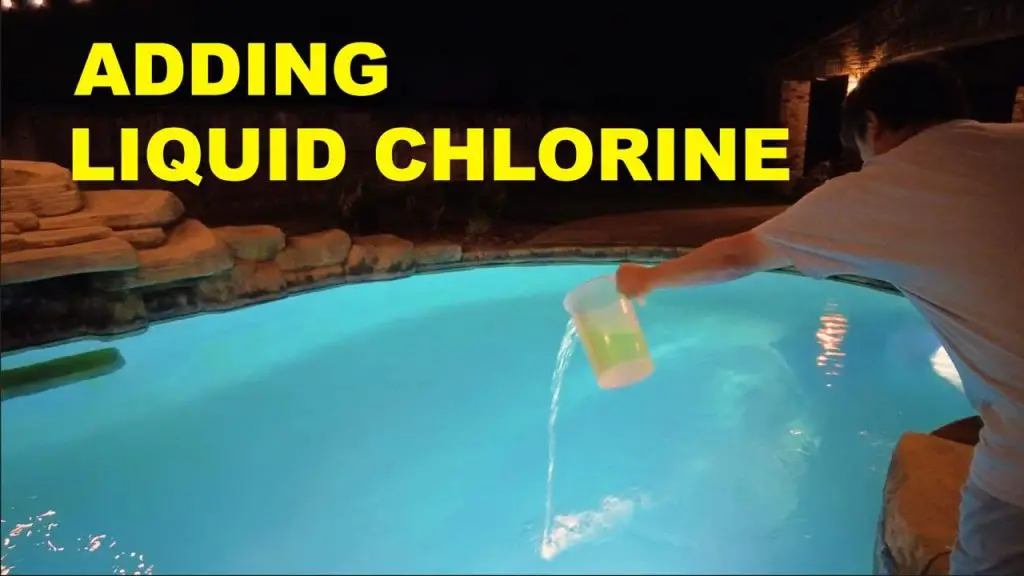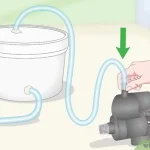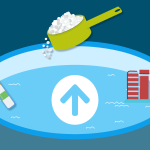To determine the accurate amount of liquid chlorine to add to your pool, use the formula of 1 gallon per 10,000 gallons of water. Introducing liquid chlorine to your pool is essential for maintaining proper water sanitation.
By adding the appropriate amount of liquid chlorine, you can effectively eradicate harmful bacteria and algae growth, ensuring a safe and enjoyable swimming experience for all. However, it is crucial to determine the exact quantity to add for optimal results.
To calculate this, you must consider the volume of water in your pool. Remember, the standard measure is 1 gallon of liquid chlorine per 10,000 gallons of pool water. By adhering to this guideline, you can maintain a clean and hygienic swimming pool throughout the season, minimizing the risk of water-related health issues. Keep reading to discover the steps required for adding liquid chlorine accurately to your pool.
The Importance Of Chlorine In Pool Maintenance
Efficient pool maintenance is vital for ensuring the health and safety of swimmers. Chlorine, a key component of pool maintenance, plays a crucial role in keeping the water clean, safe, and hygienic. Understanding the significance of chlorine and knowing how much liquid chlorine to add to your pool is essential for maintaining optimal water quality. In this blog post, we’ll delve into the importance of chlorine in pool maintenance and provide valuable insights into chlorine as a sanitizer and its role in maintaining water quality.
Chlorine As A Sanitizer
Chlorine acts as a powerful sanitizer in pool water, effectively eliminating harmful bacteria, algae, and other contaminants. By introducing chlorine into the pool, you create a protective barrier that prevents the growth and spread of bacteria and algae, safeguarding the health of swimmers. A proper understanding of the role of chlorine as a sanitizer is crucial for maintaining a clean and sanitary swimming environment.
Chlorine’s Role In Water Quality
Chlorine plays a vital role in preserving the overall water quality of the pool. It helps in maintaining a balanced pH level by neutralizing acids and alkalis, ensuring that the water is neither too acidic nor too basic. This, in turn, prevents skin and eye irritation among swimmers, providing a refreshing and comfortable swimming experience. Additionally, chlorine effectively oxidizes organic matter, keeping the water clear and free from unpleasant odors. Understanding the significance of chlorine in preserving water quality is crucial for ensuring a safe and enjoyable swimming environment.

Credit: www.fix.com
Factors Affecting Chlorine Dosage
Factors influencing the amount of liquid chlorine required for pool treatment range from water temperature to pH levels, with high temperatures and sunlight necessitating more chlorine. Ensure proper pool testing and follow guidelines for safe and effective chlorine dosing to maintain water clarity and hygiene.
When determining the right amount of liquid chlorine to add to your pool, various factors come into play. These factors can impact the chlorine dosage needed to maintain proper water sanitation. Let’s delve into the key factors affecting chlorine dosage:Pool Size
The size of your pool directly influences the amount of liquid chlorine required for effective sanitation. Larger pools need more chlorine to maintain proper levels.Temperature And Sunlight Exposure
Temperature and sunlight exposure can accelerate chlorine dissipation in the pool. Higher temperatures and prolonged sunlight exposure may necessitate a higher chlorine dosage.Bather Load
The number of swimmers in the pool, known as the bather load, affects chlorine demand. More swimmers translate to increased organic contaminants, requiring higher chlorine levels. In summary, pool size, temperature, sunlight exposure, and bather load are crucial factors influencing the amount of liquid chlorine needed for your pool’s optimal sanitation.Understanding Liquid Chlorine
Liquid chlorine is a popular choice for pool owners when it comes to sanitizing and maintaining their pools. Its effectiveness in killing bacteria and algae, along with its affordability and availability, make it an ideal option. However, understanding the concentration variations, as well as proper storing and handling, is essential for its efficient use. Let’s dive deeper into these aspects.
Concentration Variations
The concentration of liquid chlorine can vary depending on the brand or supplier. It is typically measured as a percentage of available chlorine. The most common concentrations available in the market are 10%, 12.5%, and 15%. It’s important to know the concentration of the liquid chlorine you are using, as it directly affects the amount you need to add to your pool.
Here’s a simple breakdown of the amount of liquid chlorine you would add to a 10,000-gallon pool for different concentrations:
| Liquid Chlorine Concentration | Amount to Add for 10,000 Gallons |
|---|---|
| 10% | 1 gallon |
| 12.5% | 0.8 gallon |
| 15% | 0.7 gallon |
Always refer to the product label or consult the manufacturer’s instructions to determine the appropriate amount of liquid chlorine for your specific pool size and concentration.
Storing And Handling
Proper storing and handling of liquid chlorine is crucial to ensure its effectiveness and safety. Here are some important points to keep in mind:
- Store liquid chlorine in a cool, dry, and well-ventilated area, away from direct sunlight and any sources of heat or flame.
- Keep the container tightly closed and upright to prevent leaks or spills.
- Always handle liquid chlorine with care, wearing protective gloves and eyewear.
- Avoid mixing liquid chlorine with other chemicals, as it can result in hazardous reactions.
- When adding liquid chlorine to your pool, pour it slowly and steadily around the edges, avoiding direct contact with people or pool equipment.
- After adding liquid chlorine, ensure proper circulation by running the pool pump for at least 4-6 hours.
- Regularly monitor the chlorine levels in your pool using a reliable test kit and adjust the dosage accordingly.
By understanding the concentration variations and following proper storing and handling practices, you can effectively utilize liquid chlorine to maintain a clean and safe swimming pool.
Credit: www.quora.com
Calculating Chlorine Dosage
To calculate the chlorine dosage for your pool, use a pool water testing kit to measure the chlorine levels. Determine the size of your pool and refer to the manufacturer’s guidelines to determine how much liquid chlorine to add. It’s important to follow the recommended dosage for safe and effective pool maintenance.
Calculating Chlorine Dosage Using Pool Volume and Test Kits One of the key factors in maintaining crystal clear and safe pool water is ensuring the right amount of chlorine is added. Chlorine helps kill harmful bacteria, algae, and other contaminants that can make your pool water cloudy or even harmful to swim in. But how do you know how much chlorine to add to your pool? Calculating the chlorine dosage requires considering the pool volume and using test kits to measure the current chlorine levels. First, determine the volume of your pool. You can easily calculate this by measuring the length, width, and average depth of your pool, and then plug these numbers into the following formula: Pool Volume (in gallons) = Length (in feet) × Width (in feet) × Average Depth (in feet) × 7.5 Once you have determined your pool volume, you can move on to testing the chlorine levels using a pool water test kit. These kits typically include test strips or liquid reagents to measure the free chlorine levels in your pool water. To use a test strip, simply dip it into the pool water and compare the color it turns to the provided chart. The color indicates the concentration of free chlorine in the water. If the test shows a low chlorine level, you will need to add more chlorine to reach the recommended range. Adjusting Dosage for Specific Conditions When adjusting the chlorine dosage, it’s important to consider specific conditions that may affect the required dosage. Factors such as pool usage, weather, and water temperature can influence the effectiveness of chlorine and the rate at which it dissipates. For high usage pools, such as those frequented by a lot of swimmers or used for pool parties, you may need to increase the chlorine dosage to compensate for the increased demand and potential contaminants introduced into the water. Weather conditions can also impact chlorine levels. In hot and sunny weather, chlorine can degrade faster due to increased evaporation and exposure to sunlight. In contrast, cooler weather can slow down chlorine degradation. Therefore, it’s advisable to monitor and adjust the dosage accordingly based on the prevailing weather conditions. Water temperature is another factor to consider. Higher water temperatures can accelerate the growth of bacteria and algae, which may require higher chlorine levels to combat. Conversely, cooler water temperatures may allow for a lower chlorine dosage. In conclusion, calculating the correct chlorine dosage for your pool involves considering the pool volume and using pool water test kits to measure the existing chlorine levels. By taking into account specific conditions such as pool usage, weather, and water temperature, you can ensure effective and efficient chlorine treatment in your pool. Keep in mind that maintaining the appropriate chlorine levels is essential for the health and enjoyment of your pool.Determining Ideal Chlorine Levels
When it comes to maintaining a clean and safe swimming pool, one of the most important factors to consider is the chlorine level. Chlorine is a powerful disinfectant that helps kill bacteria, viruses, and other contaminants in the pool water. Determining the ideal chlorine levels is crucial to ensure that your pool remains clean and safe for swimmers.
Free Chlorine Levels
Free chlorine refers to the amount of chlorine available in the pool water to kill bacteria and other contaminants. It is important to maintain the proper free chlorine levels to ensure that your pool is effectively sanitized. The ideal free chlorine level for a swimming pool is typically between 1 and 3 parts per million (ppm).
To determine the free chlorine levels in your pool, you can use a test kit specifically designed to measure chlorine levels. This kit will provide you with a color-coded scale that indicates the concentration of free chlorine in your pool water. Simply follow the instructions provided with the kit to obtain an accurate reading of your free chlorine levels.
Combined Chlorine And Chloramines
Combined chlorine, also known as chloramines, is formed when free chlorine reacts with contaminants in the water, such as urine, sweat, and sunscreen. Unlike free chlorine, chloramines are ineffective at killing bacteria and can cause unpleasant odors and irritate swimmers’ eyes and skin. Therefore, it is important to monitor and manage the levels of combined chlorine in your pool.
The ideal level of combined chlorine in a swimming pool should be below 0.2 ppm. If the combined chlorine levels exceed this threshold, it indicates that there are too many contaminants in the water and the pool needs to be shocked or superchlorinated. Shocking your pool involves adding a higher dose of chlorine to quickly remove the chloramines and restore the proper balance of sanitizer.
To determine the combined chlorine levels in your pool, you can use a test kit that specifically measures this parameter. The test kit will provide you with a color-coded scale that indicates the concentration of combined chlorine in your pool water. If the test indicates high levels of combined chlorine, it is important to take immediate action to rectify the issue.
Maintaining the ideal chlorine levels in your pool is crucial for ensuring a clean and safe swimming environment. Regularly testing and monitoring the free chlorine and combined chlorine levels will help you maintain optimal sanitizer levels and prevent the growth of harmful bacteria and algae. By following these guidelines and taking the necessary steps to adjust chlorine levels as needed, you can enjoy a crystal-clear and inviting pool all season long.

Credit: m.youtube.com
Best Practices For Adding Liquid Chlorine
Adding liquid chlorine to your pool is essential for maintaining clean and safe water. Following best practices ensures that the chlorine is applied effectively and safely, maximizing its benefits for your pool.
Applying Chlorine Safely
It’s crucial to handle liquid chlorine with caution to prevent any accidents. To apply it safely, wear protective gear such as gloves and goggles, and ensure proper ventilation in the area. Avoid splashing or spilling, and use a dedicated measuring container to minimize contact with the chemical.
Distribution And Mixing
When adding liquid chlorine to the pool, distribute it evenly across the water surface for uniform dispersion. To ensure thorough mixing, it’s recommended to run the pool pump for at least 24 hours after adding the chlorine. This helps in achieving an effective distribution and integration of the chemical into the water.
Monitoring Chlorine Levels
When it comes to maintaining a healthy and safe pool environment, monitoring chlorine levels is crucial. Keeping the right balance of chlorine is key to preventing the growth of harmful bacteria and algae, ensuring that your pool water is clean and safe for swimmers.
Regular Testing
Regularly testing the chlorine levels in your pool is essential to ensure that it remains at an optimal and safe level. Using a reliable testing kit, you can accurately measure the chlorine content in your pool water. Ideally, test the chlorine levels at least twice a week to maintain the balance and adjust the dosage accordingly.
Understanding Test Results
Once you have conducted the test, it is important to understand the results. The ideal chlorine level for a swimming pool is between 1.0 and 3.0 parts per million (ppm). If the chlorine level is below 1.0 ppm, this indicates that the pool may not be adequately sanitized. On the other hand, if the level exceeds 3.0 ppm, it can cause skin and eye irritation for swimmers.
Troubleshooting Chlorine Imbalance
Proper chlorine levels are essential for pool maintenance. Let’s address common issues that may arise.
Dealing With High Chlorine Levels
- If levels are too high, dilute by adding more water.
- Test water regularly to monitor chlorine levels.
- Avoid swimming until levels drop to safe range.
Addressing Low Chlorine Levels
- Add liquid chlorine incrementally to raise levels.
- Consult pool professional for guidance if needed.
- Maintain proper chlorine levels for a clean pool.
Conclusion
To sum up, maintaining the right balance of liquid chlorine in your pool is crucial for safe and clean water. By following the proper guidelines and calculations, you can ensure your pool remains a refreshing oasis. Keep your pool sparkling with the right amount of liquid chlorine!





